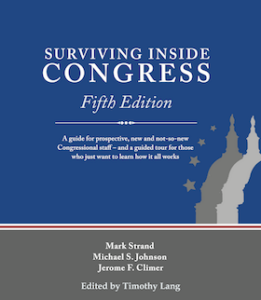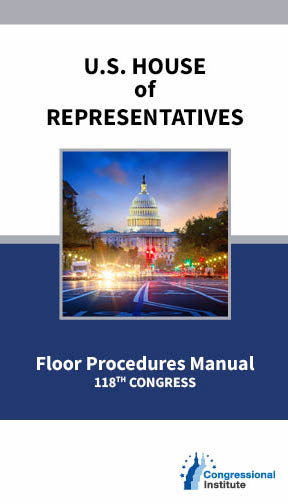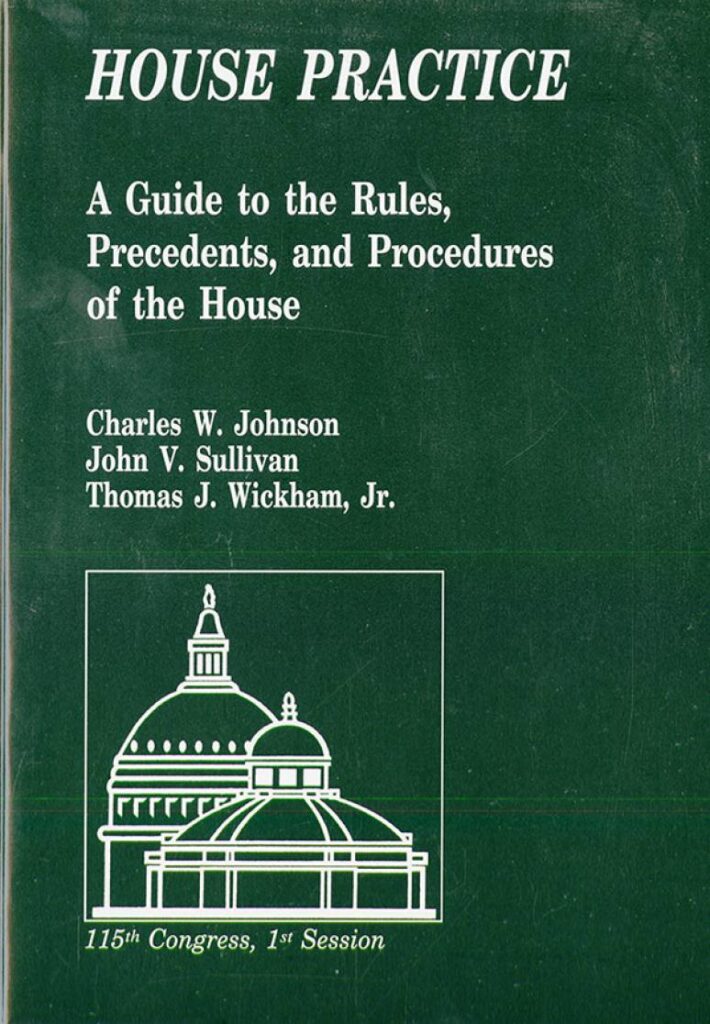So, you’ve just been elected a Member of Congress, or landed a job as a congressional staffer. Perhaps you served on a congressional campaign and the new Member has just hired you to work in their government office. Unless you’ve served as a congressional staffer before, you might be utterly perplexed at what your next steps should be. To help you forge your way on Capitol Hill, we’ve assembled a guide to various congressional staff resources and organizations that can help.
Books

Surviving Inside Congress, 5th Edition
Mark Strand, Michael S. Johnson & Jerome F. Climer
Congressional Institute
Surviving Inside Congress, the Congressional Institute’s signature publication, is a guide to how Congress operates for Members of Congress, current and prospective congressional staff, and anyone else interested in the Legislative Branch. It explains various issues such as the staff positions, the committee process, the basics of Floor procedure and legislative tactics, congressional ethics, polarization and partisanship, and much more. The Congressional Institute provides free copies to Members of Congress and staff. Members and staff may request a copy by sending an email from their official email account to book@conginst.org.
Congressional Procedure: A Practical Guide to the Legislative Process in the U.S. Congress
Richard A. Arenberg
Arenberg, who served for many years as a Senate staffer, offers an introduction to the legislative process starting with the Constitution and ending with the President’s veto or signature. Along the way, he shows the reader congressional committees, the differences between the House and Senate, how the two Chambers resolve their differences, and many other issues. Also covered are additional congressional powers and responsibilities, such as the Senate’s confirmation process and treaty ratifications. The book is excellently organized and includes diagrams to illustrate concepts as well.
(In addition to Arenberg’s Congressional Procedure, readers should also read his Defending the Filibuster: The Soul of the Senate, co-authored with former Senate Parliamentarian Robert B. Dove. As the title unabashedly proclaims, it is an apologia for the Senate’s filibuster, and one of the best at that.)
Congressional Procedures and the Policy Process, 11th Edition
Walter J. Oleszek, Mark J. Oleszek, Elizabeth E. Rybicki, William Alan Heniff
Written by staff of the Congressional Research Service, Congress’ in-house think tank, this book covers the legislative process in-depth. One particular advantage is that the authors treat the congressional budget process early in the book, which is an important editorial decision since the budget affects nearly every aspect of the legislative process and very many of the country’s most difficult-to-resolve policy issues. Now in its 11th edition, the book has been updated frequently to reflect the contemporary Congress accurately.
Setting Course: A Congressional Management Guide
Congressional Management Foundation
Setting Course, published by the Congressional Management Foundation,provides extensive nuts-and-bolts guidance on establishing and maintaining a congressional office. Divided into three parts, it offers advice for everyone from Members-elect to long-serving veterans. It covers various issues including budgeting for an office, internal and external communications, strategic planning, how to hire staff, and many others.

U.S. House of Representatives Floor Procedures Manual
Congressional Institute
The U.S. House of Representatives Floor Procedures Manual is an easy-to-understand guide to debate on the Floor of the House of Representatives. It explains issues like the House’s daily schedule, how bills come to the Floor, how to offer an amendment, and how to obtain time to speak. Staff from the House Rules Committee update it at the beginning of each Congress. Small enough to fit into a pocket, Members and staff can easily carry it with them to the Chamber and refer to it during debate. The Congressional Institute provides free copies to Members of Congress and staff. Members and staff may request a copy by visiting our Floor Procedures Manual request page.
The Floor Procedures Manual is also published on the Congressional Institute’s website: House Floor Procedures Manual Digital Edition.
Senate Procedure and Practice, Fourth Edition
Martin B. Gold
Written by veteran Senate staffer Martin B. Gold, Senate Procedure and Practice is an excellent introduction to how the Senate operates. Gold offers a readable, yet comprehensive, explanation of various aspects of the Senate, including debate on the Floor, committee procedure, and the budget process. One particularly useful aspect of this book is its extensive case studies that illustrate how the Senate operates today.

House Practice: A Guide to the Rules, Precedents, and Procedures of the House
Charles W. Johnson, John V. Sullivan, Thomas J. Wickham, Jr.
Written by the Parliamentarians of the House, House Practice is a one-volume distillation of the Chamber’s parliamentary procedure. The subtitle’s reference to itself as a “guide” to House procedure is accurate, though in this case, the term should not be construed to connote “simple” or “basic.” It’s a beefy book, and those new to procedure would do well to read through a more introductory work, such as Surviving Inside Congress or the House Floor Procedures Manual, first. Once a person has a more basic introduction to House procedure, he or she can really benefit from this work, since it delves more fully into the details of the rules and precedents, and attention to parliamentary details is indispensable to legislating effectively. (Photo: U.S. Government Publishing Office)
How Our Laws Are Made
John V. Sullivan
The name says it all. First drafted by the House Judiciary Committee and updated by the former Parliamentarian of the House, this pamphlet explains how Congress enacts a bill. In addition to that, it explains other topics such as the terms and elections of Representatives and Senators, oversight of the Executive Branch, and how laws are published and codified. Clocking in at fewer than 70 pages, it’s a manageable intro to the legislative process. It also has the distinction of being published pursuant to a vote of the House and Senate, making it an official publication of the U.S. Federal Government.
Though printed copies of How Our Laws Are Made are available for purchase, a PDF is available online for free: How Our Laws Are Made.
Organizations and Institutions
Congressional Institute (CI)
We’re here to help! The Congressional Institute, founded in 1987, is a non-profit dedicated to helping Members of Congress better serve their constituents and help constituents better understand the public. We publish research explaining parliamentary procedure, how to reform Congress, how Members of Congress can communicate with the public more effectively, and the like. Our signature educational resource is Surviving Inside Congress, a guide to life on Capitol Hill. We are happy to provide each Member and staffer a free copy. Members or staffers interested in free copies may send an email from their official email accounts to book@conginst.org.
One of the Congressional Institute’s major initiatives is to provide ideas and resources on issues relating to congressional reform. If there’s one thing that many Members of Congress and members of the public of all political persuasions agree on, it’s that Congress needs to be reformed to make it more effective. To aid reform efforts, the Congressional Institute has produced research on issues like fixing the broken budget process, restoring Members’ rights to offer amendments on the Floor, civility and other topics.
The Congressional Institute also proudly sponsors the House’s Congressional Art Competition. It is an annual opportunity for House Members to promote the artistic achievements of their high school aged constituents. Each Member of the House may hold an art competition in their District and the winner’s artwork will be displayed in the Cannon Tunnel for a year. Members and staff who have questions about the Congressional Art Competition may email art@conginst.org for more information. New Members of Congress are strongly encouraged to participate!
Congressional Institute Reform Concepts
Congressional Institute Special Projects
Congressional Institute E-newsletter Sign-Up
Congressional Institute Facebook Page
Congressional Institute Twitter Feed
Congressional Management Foundation (CMF)
The Congressional Management Foundation (CMF) is another non-profit dedicated to increasing the effectiveness of Members of Congress and educating the public about how Congress operates. CMF publishes Setting Course: A Congressional Management Guide, which explains how new Members can establish their offices and how incumbents can improve their operations. They have numerous other publications on a whole host of topics, including scheduling, mail operations and communications. They also offer staff training and office strategic planning retreats.
Congressional Management Foundation
The House and Senate Parliamentarians
The House and Senate Parliamentarians are the official advisors to their respective Chambers’ presiding officers on the rules of parliamentary procedure. In the House, the Parliamentarian (or a deputy) will be to the Speaker’s or Speaker pro tempore’s right (the viewer’s left). In the Senate, the Parliamentarian is seated on the lower level of the dais, a little to the Vice President’s or President pro tempore’s right (the viewer’s left). During House and Senate proceedings they will guide the presiding officer on how to govern debate in a way consistent with the Chamber’s rules and precedents. Their roles are only advisory, and the presiding officers may rule in ways that conflict with the Parliamentarians’ advice.
In addition to advising the presiding officers, each Chamber’s Parliamentarian (and their deputies) are available to serve its Members generally. Members and their staffers may ask the Parliamentarians and their staffers for instruction and guidance on procedure. Members and staff who wish to advance bills and offer amendments would be wise to consult with their Chamber’s Parliamentarian to ensure that their legislation conforms to the rules. Doing so may allow them to make modifications in case a provision would run afoul of the rules. Such consultations are confidential.
The House and Senate Parliamentarians are non-partisan.
Congressional Research Service (CRS)
The Congressional Research Service (CRS) is sometimes called “Congress’ think tank.” CRS, a division of the Library of Congress, was created to support Members and staff by producing research on various policy and procedural issues. CRS is non-partisan and reports are intended not to advocate for or against particular policies. CRS retains several experts on the U.S government and Congress, making it an excellent resource to learn about the legislative process. Member offices may request that CRS produce reports on particular issues.
Congressional Research Service
House and Senate Ethics Committees
Each Chamber has numerous ethics rules, which supplement laws governing public officials, and violations can lead to serious consequences for both Members and staffers. If Members and staff and staff find themselves with questions about ethics rules, they can turn to their Chamber’s Ethics Committee for guidance on courses of action that stay within bounds. Such consultations are confidential. Failure to follow ethics laws and rules could mean that Members and staff face the Ethics Committees in their other functions: Investigators ethical violations and enforcers of the rules. It’s much more pleasant to deal with the Ethics Committees as educators rather than enforcers, so consulting them in cases of doubt and establishing a pattern of adherence to the rules is always the best policy.
POPVOX
POPVOX is a platform that allows the public to track legislation and Members of Congress and staff track the sentiment of the public and the advocacy community. Constituents can sign up to weigh in on specific bills and send messages to their Members of Congress. Organizations can sign in to submit statements endorsing or opposing legislation. Members and staff can see receive messages from their constituents and track what outside organizations are saying.
Committee on House Administration and Senate Committee on Rules and Administration
Capitol Hill is like a city within a city, and the House and Senate administration committees are like the city government. In fact, the Chairman of the House Administration Committee is informally called “the Mayor of Capitol Hill.” These committees oversee things like how much money each Member and Committee will receive for their budget, the U.S. Capitol Police, congressional postal operations, how office space is allotted, how Members can communicate with the public, and loads of other responsibilities. Members and staff can turn to the House and Senate administration committees for guidance on how to understand and apply the rules.
In addition to these administrative functions, these committees also have jurisdiction over disputed elections to their respective Chambers. According to the U.S. Constitution, “Each House shall be the Judge of the Elections, Returns, and Qualifications of its own Members.” If the election to a seat is in doubt, the House or Senate administration committee will study the issue and then its parent Chamber will vote on its recommendation.
The Senate Committee on Rules and Administration also has jurisdiction over legislation that affects the Chamber’s rules and procedures. The Committee on House Administration does not exercise a comparable jurisdiction; the House Rules Committee does. The House Rules Committee exerts extensive influence over the Chamber’s parliamentary procedure, and the Senate Committee on Rules and Administration exerts nowhere near the same amount of influence.
Committee on House Administration
Senate Committee on Rules and Administration
Think Tanks
D.C. is full of think tanks, with experts from all over the world and from all political persuasions. Some institutions are closely aligned with a political ideology. Others have less of a philosophical or political commitment on an institutional level though their scholars might openly profess a particular political viewpoint.
We hope these congressional staff resources help. Best wishes to all Capitol Hill newcomers!